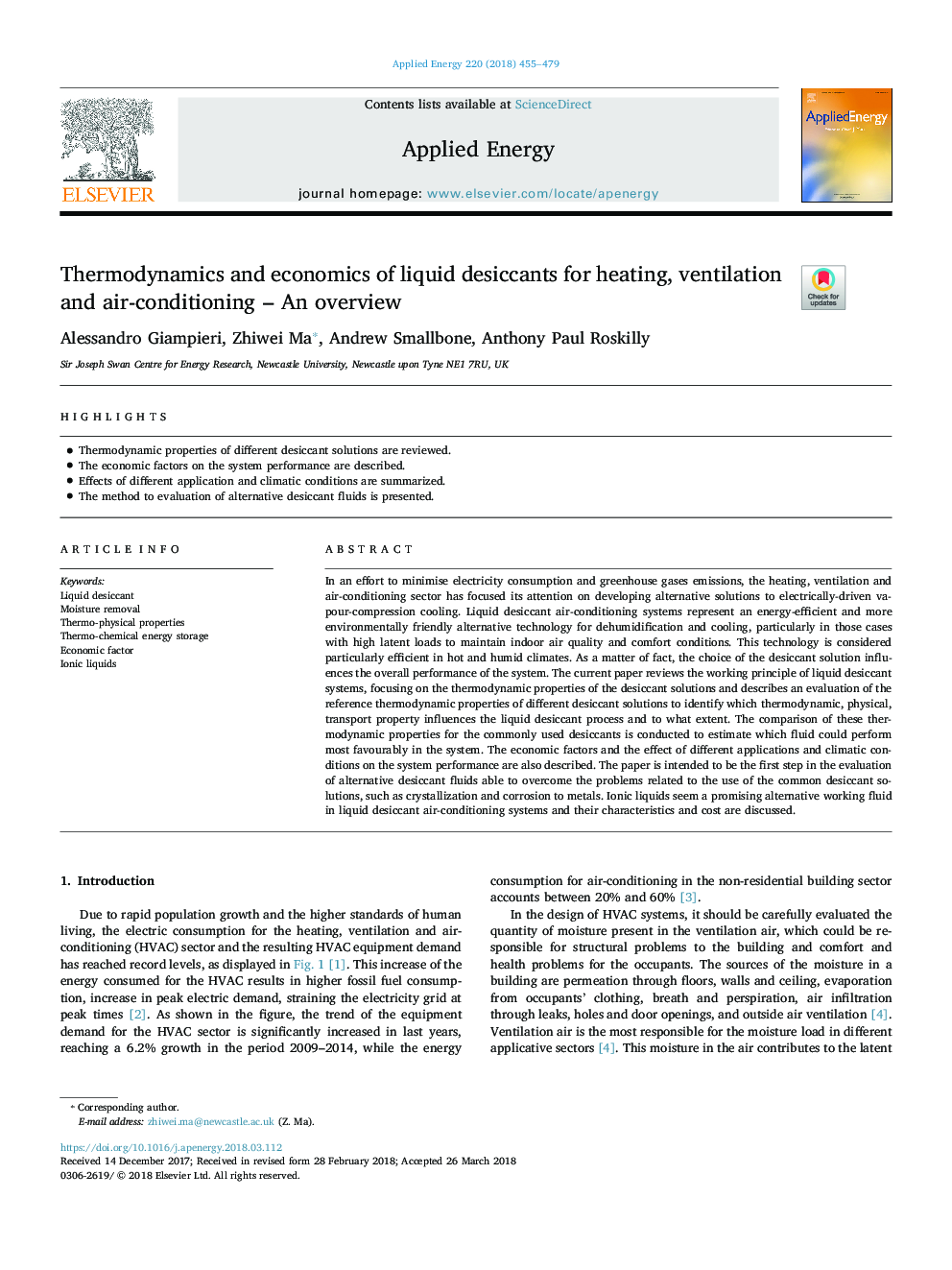| کد مقاله | کد نشریه | سال انتشار | مقاله انگلیسی | نسخه تمام متن |
|---|---|---|---|---|
| 6680398 | 1428070 | 2018 | 25 صفحه PDF | دانلود رایگان |
عنوان انگلیسی مقاله ISI
Thermodynamics and economics of liquid desiccants for heating, ventilation and air-conditioning - An overview
ترجمه فارسی عنوان
ترمودینامیک و اقتصاد خشکی مایع برای گرمایش، تهویه و تهویه مطبوع - یک مرور کلی
دانلود مقاله + سفارش ترجمه
دانلود مقاله ISI انگلیسی
رایگان برای ایرانیان
کلمات کلیدی
مایع خشک کن، حذف رطوبت، خواص حرارتی فیزیکی، ذخیره انرژی حرارتی، عامل اقتصادی، مایعات یونی،
ترجمه چکیده
در تلاش برای به حداقل رساندن مصرف برق و انتشار گازهای گلخانه ای، بخش گرمایشی، تهویه و تهویه مطبوع توجه خود را در توسعه راه حل های جایگزین برای خنک کننده بخار فشرده شده بر مبنای الکتریکی متمرکز کرده است. سیستم های تهویه مطبوع مایع خشک کن، یک تکنولوژی جایگزین برای انرژی خورشیدی و محیط زیست را برای رطوبت و خنک کننده، مخصوصا در مواردی با بارهای پنهان بالا برای حفظ کیفیت هوا در محیط داخلی و شرایط راحتی، نشان می دهد. این تکنولوژی در محیط های گرم و مرطوب به طور خاص کار می کند. به عنوان یک واقعیت، انتخاب محلول خشک کننده بر عملکرد کلی سیستم تاثیر می گذارد. مقاله حاضر بررسی اصل کار سیستم های مایع خشک کن با تمرکز بر خواص ترمودینامیکی محلول های خشک کننده و توصیف ارزیابی خواص مرجع ترمودینامیکی راه حل های مختلف خشک کن برای شناسایی ویژگی های ترمودینامیکی، فیزیکی و حمل و نقل، تحت تاثیر فرایند مایع خشک کننده و چه اندازه. مقایسه این خواص ترمودینامیکی برای مواد شیمیایی معمولی مورد استفاده قرار می گیرد تا برآوردی که مایع می تواند در سیستم مطلوب ترین عملکرد را انجام دهد. عوامل اقتصادی و تاثیر برنامه های مختلف و شرایط آب و هوایی بر عملکرد سیستم نیز شرح داده شده است. مقاله در نظر گرفته شده است که اولین گام در ارزیابی مایعات جایگزین خشک کننده است که قادر به غلبه بر مشکلات مربوط به استفاده از راه حل های معمول کولر، مانند کریستالیزاسیون و خوردگی به فلزات است. مایعات یونی به نظر می رسد یک مایع جایگزین امیدوارکننده در سیستم های تهویه مطبوع خشک مایع هستند و ویژگی ها و هزینه های آنها مورد بحث قرار می گیرد.
موضوعات مرتبط
مهندسی و علوم پایه
مهندسی انرژی
مهندسی انرژی و فناوری های برق
چکیده انگلیسی
In an effort to minimise electricity consumption and greenhouse gases emissions, the heating, ventilation and air-conditioning sector has focused its attention on developing alternative solutions to electrically-driven vapour-compression cooling. Liquid desiccant air-conditioning systems represent an energy-efficient and more environmentally friendly alternative technology for dehumidification and cooling, particularly in those cases with high latent loads to maintain indoor air quality and comfort conditions. This technology is considered particularly efficient in hot and humid climates. As a matter of fact, the choice of the desiccant solution influences the overall performance of the system. The current paper reviews the working principle of liquid desiccant systems, focusing on the thermodynamic properties of the desiccant solutions and describes an evaluation of the reference thermodynamic properties of different desiccant solutions to identify which thermodynamic, physical, transport property influences the liquid desiccant process and to what extent. The comparison of these thermodynamic properties for the commonly used desiccants is conducted to estimate which fluid could perform most favourably in the system. The economic factors and the effect of different applications and climatic conditions on the system performance are also described. The paper is intended to be the first step in the evaluation of alternative desiccant fluids able to overcome the problems related to the use of the common desiccant solutions, such as crystallization and corrosion to metals. Ionic liquids seem a promising alternative working fluid in liquid desiccant air-conditioning systems and their characteristics and cost are discussed.
ناشر
Database: Elsevier - ScienceDirect (ساینس دایرکت)
Journal: Applied Energy - Volume 220, 15 June 2018, Pages 455-479
Journal: Applied Energy - Volume 220, 15 June 2018, Pages 455-479
نویسندگان
Alessandro Giampieri, Zhiwei Ma, Andrew Smallbone, Anthony Paul Roskilly,
